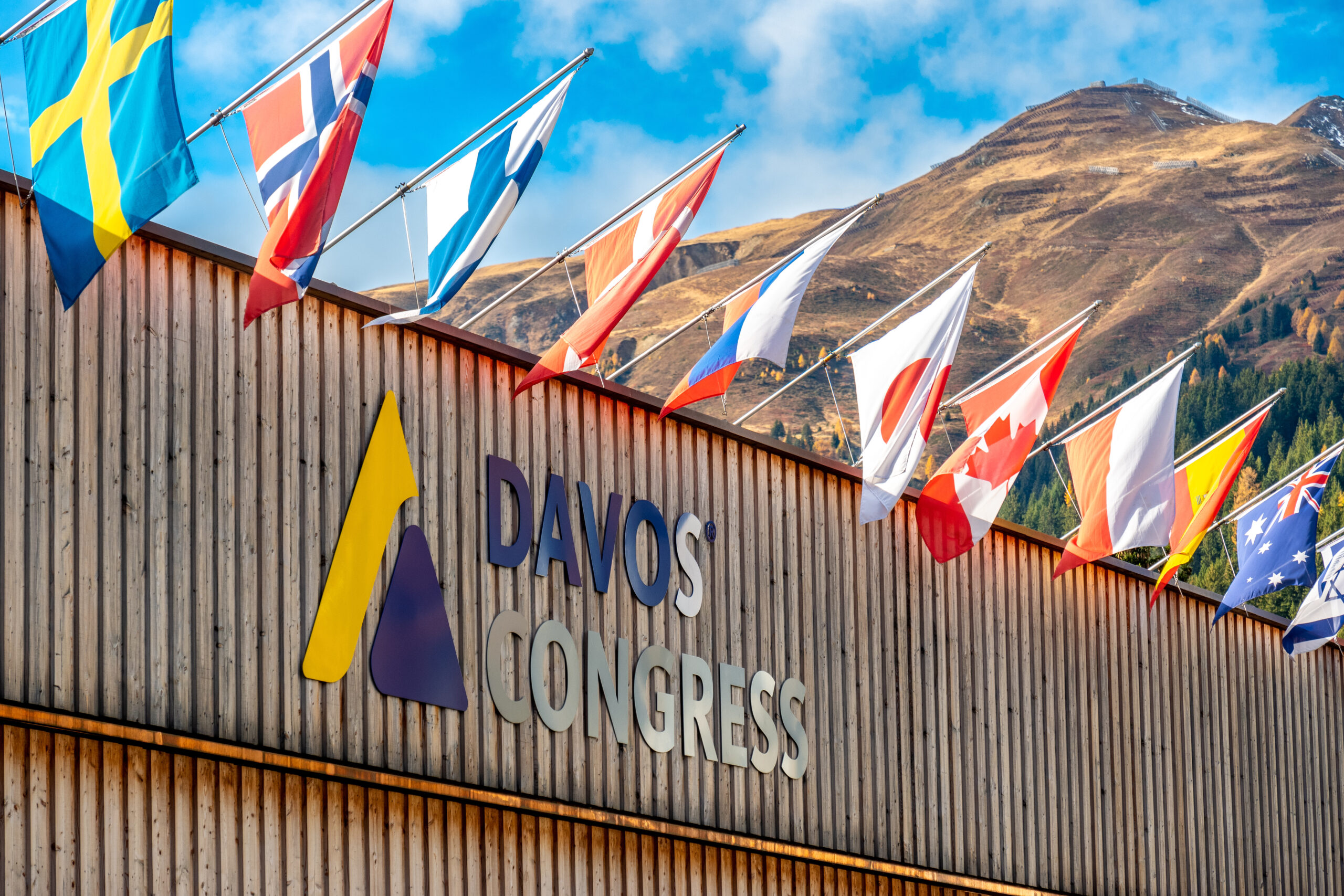When Klaus Schwab, the longtime architect of the World Economic Forum (WEF), was forced out earlier this year over accusations of financial misconduct, it seemed like the end of an era. For decades, Schwab had been the face of the organization, hosting presidents, prime ministers, and CEOs in the snowy Swiss town of Davos, where the global elite gathered each January to talk about the future of the world, man-kind, and each individual.
Schwab’s departure was followed by a brief interim period under Peter Brabeck-Letmathe, the former CEO of Nestlé, before Larry Fink—the 73-year-old co-founder of BlackRock, which manages an astonishing $12.5 trillion and exerts exorbitant influence on companies in its portfolio around the world—was tapped to lead the Forum. Fink’s appointment immediately fueled speculation: would the WEF change its orientation under one of the most powerful men in global finance?
To answer that, it helps to understand what the WEF really is, what it does, and to what extent its vision of the future depends on who sits at the top.
The Forum’s Vision of the Future
The WEF is best known for its annual Davos meetings, but its ambitions stretch far beyond cocktail parties in the Alps. In 2018, it condensed its worldview into a short video titled “8 Predictions for the World in 2030.” Just 93 seconds long, the film presented a disturbing vision of life in the not-so-distant future.
The eight predictions were as follows (the blue font is highlighted as it is in the film):
- You’ll own nothing. And you’ll be happy. Whatever you want, you’ll rent. And it’ll be delivered by drone.
- The US won’t be the world’s leading superpower. A handful of countries will dominate.
- You won’t die waiting for an organ donor. We won’t transplant organs. We’ll print new ones instead.
- You’ll eat much less meat. An occasional treat, not a staple. For the good of the environment and our health.
- A billion people will be displaced by climate change. We’ll have to do a better job at welcoming and integrating refugees.
- Polluters will have to pay to emit carbon dioxide. There will be a global price on carbon. This will help make fossil fuels history.
- You could be preparing to go to Mars. Scientists will have worked out how to keep you healthy in space. The start of a journey to find alien life?
- Western values will have been tested to the breaking point. Checks and balances that underpin our democracies must not be forgotten.
When first published, these sounded like dystopian science fiction. Today, some seem closer than many would like to admit. But more important than the predictions themselves is the question of where they came from—and what purpose they serve.
Who Writes the Script?
The “8 predictions” were not the whimsy of a futurist, but the output of the Global Future Councils, a WEF network of more than 700 experts from business, academia, government, NGOs, and international organizations. These councils are organized into 37 thematic groups—from artificial intelligence to geopolitics to space technologies.
The councils are, in effect, a distributed think tank. They draft visions, set strategic priorities, and recommend projects that align with the WEF’s mission to build “a more resilient, inclusive and sustainable future.” These ideas do not stay on paper. They are translated into initiatives, partnerships, and policies advanced by WEF’s governmental and non-governmental partners and participants worldwide.
The predictions, then, can be seen less as fortune-telling and more as a strategic roadmap—guiding corporations and governments toward profitable new sectors, regulatory frameworks, and public-private projects, replacing gradually democratic decision-making mechanisms with the collusion of political and corporate elites and subjugating individual freedoms to the rapidly expanding system of control.
The Machinery of Influence
The WEF is not a government, nor a traditional NGO. It is a wealthy institution in its own right, reporting revenues of 440 million Swiss Francs and assets of 775 million in its 2023–24 financial year. But its true influence comes from who pays to be inside the tent.
More than 1,000 multinational companies are WEF partners, contributing between CHF 60,000 and CHF 600,000 annually. These include the biggest banks (JPMorgan, Goldman Sachs, Citi), asset managers (BlackRock, State Street), tech titans (Microsoft, Google, Meta), and pharmaceutical giants (Pfizer, Moderna, AstraZeneca, Johnson & Johnson). Their membership fees and sponsorships keep the Forum flush with cash—and ensure its priorities overlap with those of its funders.
The WEF’s official self-description is “the international organization for public-private cooperation.” In practice, that means building platforms where corporations and governments can align their interests, coordinate policy, and push forward projects that blend state power with private capital. Public-private partnerships, in WEF terms, are not just about collaboration. They are a way to channel government resources, regulation, and legitimacy into advancing the strategies of private actors.
The Young Global Leaders program illustrates how the Forum extends its reach into politics and culture. Since 2004, it has trained more than 1,400 rising leaders—among them French President Emmanuel Macron, Canadian Prime Minister Justin Trudeau, NATO’s Mark Rutte, Finland’s President Alexander Stubb, and Silicon Valley entrepreneurs like Mark Zuckerberg and Sam Altman. The program equips them with networks and tools, while embedding them in the Forum’s worldview.
The result is a dense web of influence: policymakers, CEOs, and thought leaders all moving in sync with WEF’s vision of the future.
Reading Between the Predictions
Each of the eight predictions/goals carries deeper implications than the video’s slogans suggest and deserves an in-depth analysis of its own. They all foreshadow a broad spectrum of earth-shattering changes to global economies, politics, and cultures. The list below only hints at some of the meanings densely packed in the predictions.
- “You’ll own nothing” points toward an unprecedented wealth concentration, to an economy dominated by asset managers, digital platforms, and logistics firms, where ordinary people rent access to goods and services and are deprived of the freedoms associated with ownership.
- U.S. decline reflects the aspirational rise of multipolar power centers like BRICS. More provocatively, it suggests the old American-led order is a barrier to realizing WEF’s other visions.
- Organ printing and space travel highlight potential for deep artificial intervention into the human body and life, the dehumanization of the value systems for the sake of new growth markets—sectors that could drive massive profits for new industries in biotech and aerospace. Isn’t the yearning to find alien life symptomatic of the depreciation of human life and dignity?
- Reduction of meat consumption, the requirement to accommodate 1 billion refugees, and the imposition of a global tax on carbon dioxide emissions, branded as pollution, signal regulatory actions that aim to destroy agriculture, energy affordability, and demographics. These aren’t just predictions but strategic targets for industries already investing in synthetic food, green finance, and climate adaptation.
- The Western values which are going to be stressed to the breaking point are the dignity of the human person, right to life, freedom, respect for reason, rationality of human life, search for the truth, quest for good, beauty, and justice. This prediction should be seen less as a forecast than a warning: if the other changes occur, the achievements of the Christian civilization may be irreversibly lost.
Taken together, the predictions sketch not a utopia but a reset and a disruptive, high-stakes reordering of economies, societies, and culture. For the beneficiaries—global corporations and their political partners—they are opportunities. For others, they could mean dislocation, loss of autonomy, or even a new kind of unprecedented dependency on systems of total control.
Strategy or Prophecy?
How should we understand these forecasts? Two ways stand out.
First, they function as strategic targets for corporations and governments—markers of where investment, regulation, and innovation should flow to generate long-term profit.
Second, they act as self-fulfilling prophecies. By setting expectations for the future, they influence decisions today. In the absence of competing narratives, policymakers and businesses adjust to these forecasts, helping bring them into reality.
This dual function—roadmap and prophecy—is what gives the WEF’s predictions such weight. They are less about foreseeing the world of 2030 than about shaping it.
The Leadership Question
Given all this, does it matter that Larry Fink now chairs the Forum?
On one level, yes. Fink brings unmatched financial clout and a vast network of relationships across governments and corporations. His presence will likely amplify WEF’s influence in global finance and investment, especially in areas like green energy and ESG (environmental, social, and governance) strategies, where BlackRock has already been a leader.
But on another level, no. The WEF is not a one-man show. Its agenda is developed collectively by its councils, partners, and networks. The strategies are backed by the world’s largest corporations and governments, whose resources and interests dwarf the role of any single chairman.
In that sense, the WEF is leader-proof. Schwab’s ousting, Brabeck’s interim role, and Fink’s arrival matter less than the structural power of the Forum’s ecosystem. The machine keeps running, regardless of who sits at the top.
Why It Matters
The WEF is sometimes caricatured as a gathering of elites talking about problems far removed from everyday life. But its influence is far more substantial. By convening the most powerful companies and leaders, it acts as an incubator for ideas that ripple outward into laws, regulations, investments, and cultural norms.
The “8 predictions” highlight the scale of its ambition: nothing less than the total reshaping of life on earth, including ownership, power, consumption, energy, migration, and values. Whether these scenarios sound like dystopia or progress depends on one’s perspective. What’s clear is that they are not idle speculation. They are, in many ways, the blueprint of the global establishment.
And leadership changes—whether from Schwab to Brabeck or Fink—are unlikely to alter that blueprint. The Forum’s vision is already embedded in the machinery of business and government. The chair may change. The direction does not.

